How to Repot Monstera Deliciosa With Aerial Roots
Repotting Monstera Deliciosa with aerial roots involves strategic steps for best health. Begin with a slightly larger pot equipped with substantial drainage holes.
Utilize a potting mix comprising peat moss, perlite, and orchid bark for ideal aeration and moisture retention. Carefully remove the plant from its current container, inspecting and trimming any unhealthy roots.
Center the Monstera in the new pot, ensuring aerial roots are spread out and not buried. Fill the pot with high-quality potting mix, maintaining the correct positioning for drainage and nutrient uptake.
Proper execution will promote vigorous growth and health for the Monstera. For further detailed steps, explore the following information.
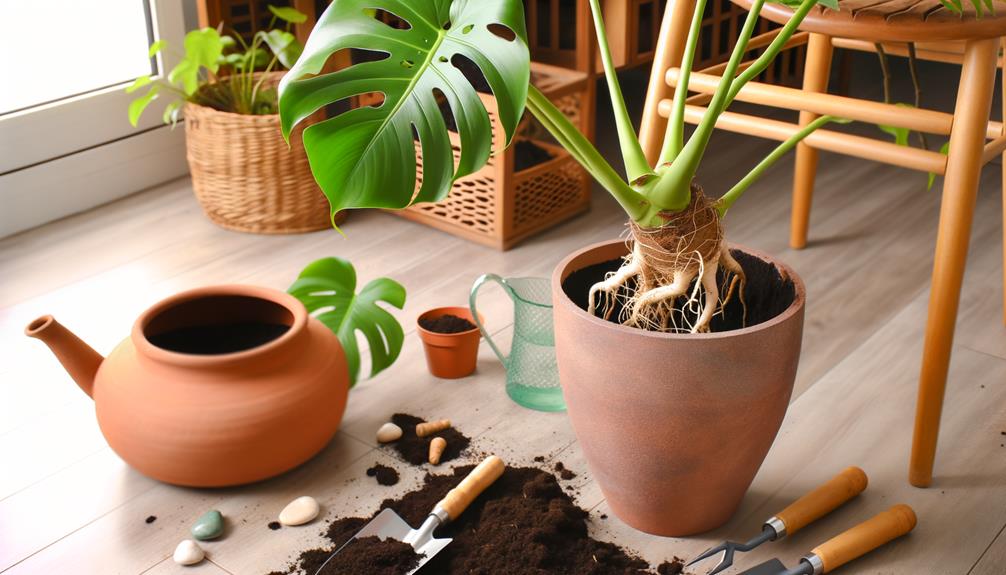
Key Takeaways
- Choose a slightly larger pot with proper drainage to accommodate Monstera Deliciosa's growth and aerial roots.
- Prepare a potting mix using peat moss, perlite, and orchid bark for optimal aeration and moisture retention.
- Gently remove the plant from the old pot, inspect roots, and trim any damaged or diseased roots with sterilized tools.
- Position the plant in the new pot, ensuring aerial roots are spread out and the plant is at the correct depth.
- Add a layer of coarse material at the pot's bottom to enhance drainage and prevent water accumulation.
Gather Your Supplies

Before repotting your Monstera Deliciosa, make sure you have all necessary supplies, including a new pot, well-draining soil mix, pruning shears, and support stakes.
A well-draining soil mix is essential for preventing waterlogging and root rot. A blend of peat, perlite, and orchid bark works effectively.
Pruning shears are vital for trimming any damaged or overgrown roots, ensuring the plant's health. Support stakes provide structural stability, particularly for plants with extensive aerial roots.
It is advisable to sterilize your pruning shears with isopropyl alcohol to minimize the risk of disease transmission. Additionally, a tarp or plastic sheet can be helpful to contain soil spillage during the repotting process.
Proper preparation sets the foundation for successful repotting.
Choose the Right Pot
Selecting an appropriate pot for your Monstera Deliciosa is essential to guarantee healthy growth and root development. Pot size should be slightly larger than the current one to accommodate new growth, with ample drainage holes to prevent waterlogging.
Additionally, consider materials like terracotta or plastic, as each has distinct advantages in moisture retention and airflow.
Pot Size Matters
Choosing the appropriate pot size is crucial for the healthy growth and development of Monstera deliciosa, especially when dealing with aerial roots. Selecting a pot that is too small can restrict root expansion, leading to stunted growth and poor nutrient uptake.
Conversely, an overly large pot can retain excessive moisture, promoting root rot. Aim for a pot that is 2-3 inches larger in diameter than the current one. This size allows sufficient space for root growth while maintaining stable moisture levels.
Additionally, consider the depth of the pot, making sure it can accommodate the plant's extensive root system. Proper pot size not only supports aerial roots but also ensures prime plant health and vigor.
Drainage Is Crucial
Ensuring proper drainage is equally important when selecting the right pot for Monstera deliciosa, as it prevents water accumulation and subsequent root rot. The chosen pot must have ample drainage holes to facilitate excess water escape. This is pivotal because Monstera deliciosa roots are prone to fungal infections in waterlogged conditions.
Additionally, placing a layer of coarse material, such as gravel or ceramic shards, at the bottom of the pot can enhance drainage efficiency. It is advisable to use a well-draining soil mix, ideally composed of peat, perlite, and bark, which allows air circulation around the roots.
Regularly checking the drainage system and avoiding overwatering are essential practices for maintaining a healthy Monstera deliciosa.
Material Considerations
The material of the pot plays a significant role in the health and growth of Monstera deliciosa, affecting factors such as moisture retention, aeration, and temperature regulation.
Terra cotta pots are highly recommended due to their porous nature, which enhances aeration and prevents waterlogging, vital for preventing root rot.
Conversely, plastic pots retain moisture longer, which can be advantageous in arid environments but may require more attentive monitoring to avoid overwatering.
Additionally, ceramic pots offer aesthetic appeal and stability but need adequate drainage holes to compensate for their non-porous nature.
When repotting, make sure the chosen pot is sufficiently large to accommodate the plant's root system and aerial roots, promoting vigorous growth and structural integrity.
Prepare the Potting Mix
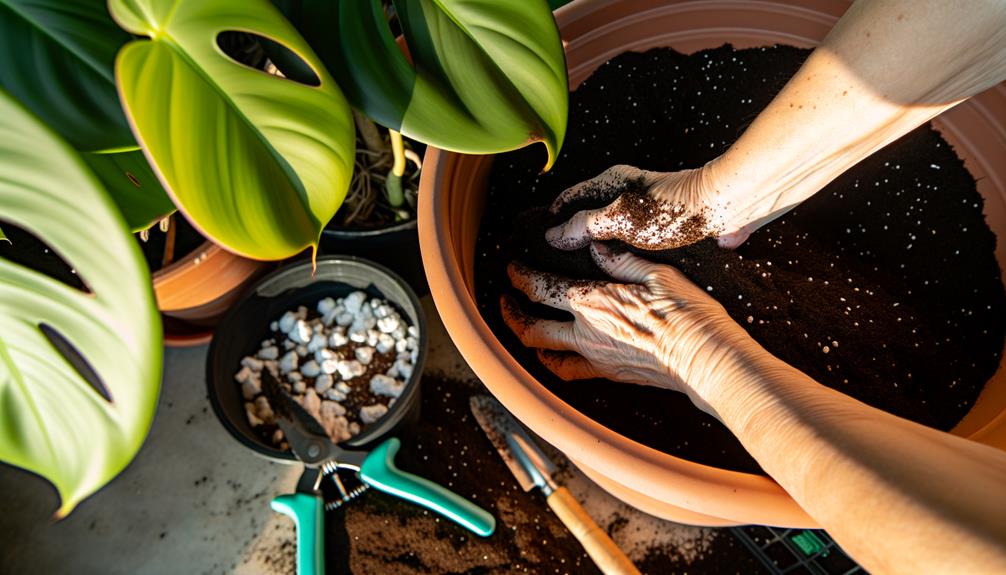
To create the best potting mix for Monstera Deliciosa, combine equal parts of peat moss, perlite, and orchid bark. Peat moss provides moisture retention and organic matter, essential for root health. Perlite enhances aeration and guarantees proper drainage, preventing root rot.
Orchid bark adds structure and mimics the plant's natural epiphytic growing conditions, supporting aerial roots. This balanced mixture promotes robust growth by facilitating nutrient uptake while preventing waterlogging. Confirm all components are thoroughly mixed to provide uniform consistency.
When selecting materials, prioritize high-quality, sterile options to reduce the risk of introducing pathogens. This custom potting mix adapts well to Monstera's unique needs, fostering a thriving, healthy plant.
Water the Plant
When repotting Monstera Deliciosa, establishing an ideal watering schedule is important to guarantee healthy root development.
Regularly check the soil moisture level using a moisture meter or by feeling the top inch of soil.
To prevent root rot, avoid overwatering by allowing the soil to partially dry out between waterings.
Optimal Watering Schedule
Ensuring the proper hydration of Monstera Deliciosa involves a balance between allowing the soil to dry out partially and maintaining consistent moisture levels. Typically, watering should occur every 7 to 10 days, but this frequency may vary based on environmental factors such as temperature, humidity, and light exposure.
Utilize room-temperature, dechlorinated water to avoid shocking the plant's root system. Apply water until it begins to drain from the bottom of the pot, ensuring thorough hydration of the root zone. Avoid overwatering, as this can lead to root rot, a common issue in Monstera Deliciosa.
Adapting the watering schedule seasonally is essential: reduce frequency during winter dormancy and increase during active growth periods in spring and summer.
Moisture Level Check
Regularly assessing the soil's moisture level is significant for maintaining the health of Monstera Deliciosa. To accurately evaluate moisture content, insert a moisture meter or your finger approximately two inches into the soil. Ideal conditions should present a moderate level of moisture; the soil should feel slightly damp but not waterlogged.
If the soil is dry, it indicates the need for watering. Conversely, if the soil feels excessively wet, refrain from additional watering to prevent root suffocation. Employing a systematic watering schedule in conjunction with moisture level checks ensures that the Monstera Deliciosa receives the best hydration necessary for robust growth.
Monitoring these levels is especially important after repotting, as root systems acclimate to their new environment.
Avoiding Overwatering Risks
Preventing overwatering is essential to safeguarding Monstera Deliciosa from root rot and other moisture-related issues. Ensuring proper drainage and adopting a strategic watering schedule are critical.
First, select a pot with adequate drainage holes to prevent water accumulation. Utilize well-draining soil, such as a mix of peat, perlite, and bark, to facilitate air circulation around the roots. Water the plant only when the top inch of soil feels dry to the touch.
- Root rot: Overwatering can lead to devastating root rot.
- Oxygen deprivation: Excess moisture reduces oxygen availability to the roots.
- Leaf yellowing: Overwatered plants often exhibit yellowing leaves.
- Pest attraction: Damp conditions are a breeding ground for pests.
- Stunted growth: Overwatering inhibits the plant's growth.
Adhering to these guidelines will promote a healthier Monstera Deliciosa.
Remove From Old Pot
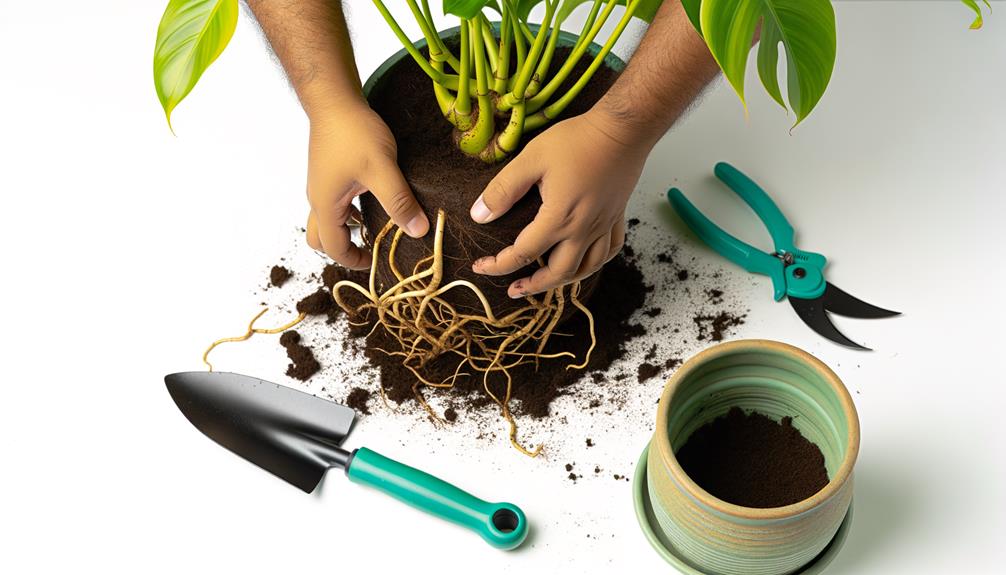
Carefully loosen the soil around the Monstera deliciosa to facilitate its removal from the old pot. Begin by gently tapping the sides of the pot to dislodge compacted soil. Use a small trowel to loosen the soil at the edges, ensuring minimal disturbance to the root system.
Grasp the base of the plant firmly and gently pull upwards, supporting the main stem with one hand while guiding the root ball out with the other. If the plant resists, avoid force; instead, lay the pot on its side and gently coax the root ball free.
This method reduces stress on the plant and minimizes potential root damage, setting the stage for a successful shift to its new container.
Inspect the Roots
Once the Monstera deliciosa is free from its old pot, the next step involves a thorough examination of the root system to evaluate its health and identify any potential issues. Carefully inspect the roots for signs of rot, disease, or pest infestation. Healthy roots should appear white or light tan and be firm to the touch. Pay particular attention to the following aspects:
- Color and Texture: Roots should be pale and firm, not mushy.
- Root Density: Look for a balanced distribution without excessive crowding.
- Aerial Roots: Check for any signs of damage or dryness.
- Odor: A foul smell may indicate root rot.
- Pests: Inspect for any insects or larvae that could harm the plant.
This thorough examination guarantees the Monstera's continued health and robust growth.
Trim Damaged Roots
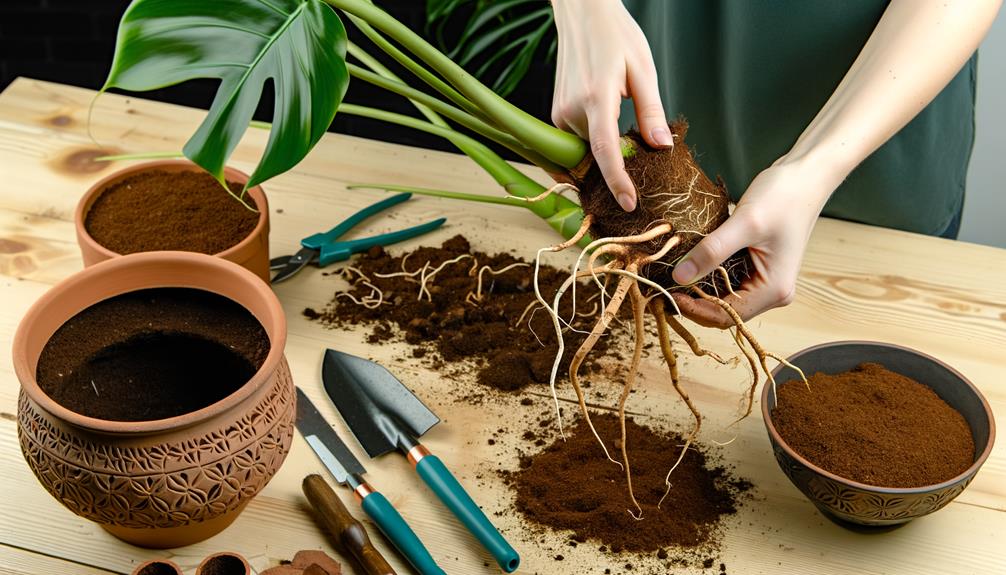
When repotting Monstera deliciosa, it is essential to identify unhealthy roots. These roots typically appear mushy, discolored, or emit an unpleasant odor.
Utilizing sterilized pruning shears or scissors guarantees the precise removal of these damaged sections, minimizing the risk of infection. Proper trimming promotes the plant's overall health and encourages robust new growth.
Identify Unhealthy Roots
To guarantee the health of your Monstera Deliciosa, begin by identifying and trimming any roots that appear brown, mushy, or emit a foul odor, as these are signs of root rot or disease. Healthy roots should be white or light tan and firm to the touch.
Unhealthy roots can compromise the entire plant, obstructing nutrient and water uptake.
- Inspect all roots meticulously
- Remove dead or decaying roots immediately
- Ensure remaining roots are free from rot
- Observe for any unusual coloration or texture
- Maintain root structure integrity
Proper Trimming Tools
Selecting the fitting trimming tools is crucial for effectively removing damaged roots, ensuring the Monstera Deliciosa remains healthy and vigorous. High-quality, sharp pruning shears or sterilized scissors are recommended for clean cuts that minimize trauma to the plant. Dull or unsterilized tools can cause jagged cuts, increasing the risk of infection and disease.
Before use, sterilize your tools with isopropyl alcohol or a diluted bleach solution to prevent pathogen transmission. When trimming, focus on removing only the visibly diseased or damaged roots, characterized by their dark, mushy, or foul-smelling appearance.
Ensuring precise cuts and proper sanitation practices will promote healthy regrowth and facilitate the successful repotting of your Monstera Deliciosa, fostering an ideal environment for its aerial and terrestrial roots.
Position in New Pot
Correct positioning of Monstera Deliciosa in its new pot is crucial to achieve top growth and stability, especially considering the plant's aerial roots. Start by centering the plant in the pot to promote even growth.
Ensure the main stem stands upright and the aerial roots are gently spread out to promote their natural growth patterns. Placement should allow for ideal light exposure, typically near an east or south-facing window. The plant's base should be at the same depth as in the previous pot, avoiding excessively burying the aerial roots.
- Attain a balanced, aesthetically pleasing appearance
- Foster strong, healthy root development
- Maximize light exposure for vibrant foliage
- Prevent toppling or leaning of the plant
- Facilitate easier watering and upkeep
Add Potting Mix
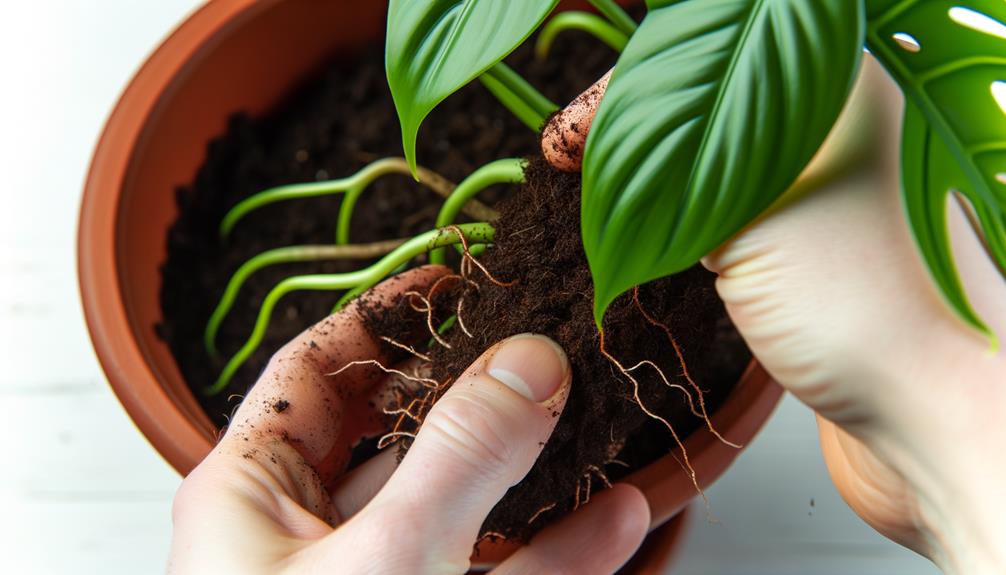
Incorporating a high-quality potting mix designed for aroids is necessary to ensure Monstera Deliciosa receives ideal drainage and nutrient availability. A suitable mixture typically includes components such as peat moss, pine bark, and perlite. These ingredients provide a balance of moisture retention and aeration, essential for preventing root rot and promoting healthy growth.
When adding the potting mix, fill the new container about one-third full, ensuring the base layer supports the plant's root system. Gradually add more mix around the roots, gently firming it to eliminate air pockets. Be mindful not to bury the aerial roots, as they play an important role in nutrient absorption and structural support.
Properly adding potting mix fosters robust plant development and longevity.
Secure Aerial Roots
To safeguard the stability and health of Monstera Deliciosa, it is crucial to properly secure its aerial roots during the repotting process.
Aerial roots serve to anchor the plant and facilitate nutrient uptake. When repotting, gently guide these roots into the new soil or moss pole to make certain they are supported and encouraged to grow.
Secure them with soft ties to prevent damage and promote stability.
- Nutrient Uptake: Enhanced absorption of moisture and nutrients.
- Structural Support: Prevents the plant from toppling.
- Aesthetic Appeal: Creates a visually pleasing arrangement.
- Health Enhancement: Reduces stress and promotes growth.
- Longevity: Ensures the plant thrives for years.
Water Thoroughly
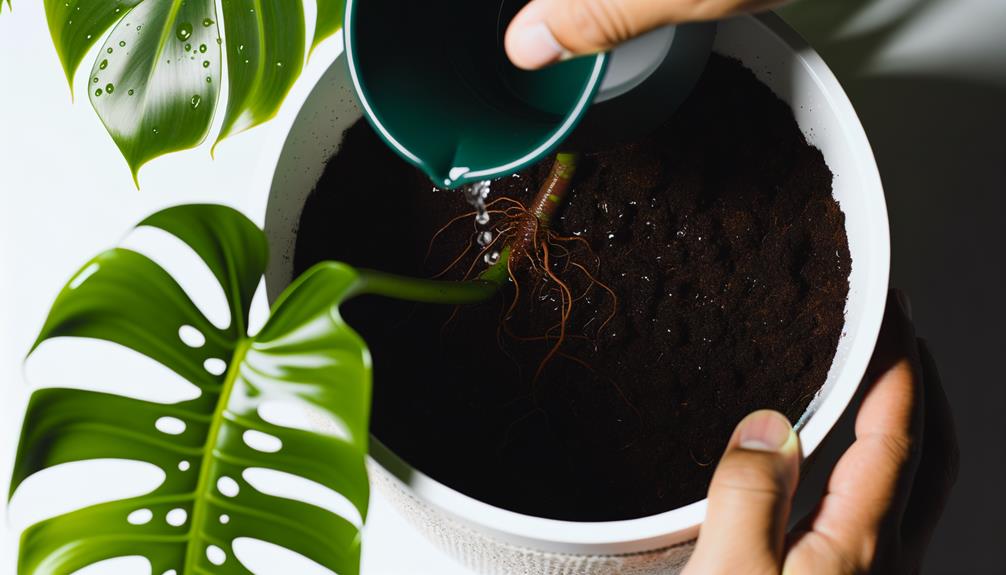
Ensuring the Monstera Deliciosa is thoroughly watered after repotting is critical for re-establishing the root system and promoting healthy growth. Begin by evenly moistening the new potting mix, ensuring water permeates through to the drainage holes. This helps to eliminate air pockets that can obstruct root development.
Use tepid water to avoid shocking the plant, and maintain a steady, even pour to saturate the soil uniformly. Be cautious not to overwater; the goal is to achieve consistent moisture without waterlogging. Assess the moisture level by inserting a finger an inch into the soil; it should feel damp but not soggy.
Proper hydration facilitates nutrient uptake and acclimates the plant to its new environment efficiently.
Post-Repotting Care
Post-repotting care is crucial for minimizing transplant shock and promoting robust growth in Monstera Deliciosa. Maintaining ideal conditions post-repotting will support the plant's recovery and adaptation to its new environment.
Key steps include:
- Watering: Maintain consistent moisture without oversaturation. Dry soil stresses the plant, while excessively wet soil risks root rot.
- Lighting: Provide ample, indirect light to facilitate photosynthesis, avoiding direct sunlight which can harm leaves.
- Humidity: Adequate humidity levels (60-80%) mimic natural habitats and stimulate aerial root development.
- Temperature: Keep temperatures between 65-85°F (18-29°C) to enhance metabolic processes.
- Observation: Monitor for signs of distress, such as yellowing leaves or wilting, and adjust care routines accordingly.
Following these guidelines will ensure a healthier, more robust Monstera Deliciosa.
Conclusion
What greater satisfaction can there be than observing the thriving growth of a properly repotted Monstera deliciosa with its aerial roots securely established?
By following the systematic steps of gathering suitable supplies, choosing a fitting pot, preparing an ideal potting mix, ensuring sufficient hydration, delicately transplanting, and providing detailed post-repotting care, one can greatly enhance the plant's health and aesthetic appeal.
Such accuracy and scientific approach enhance the longevity and vibrancy of this remarkable species.






